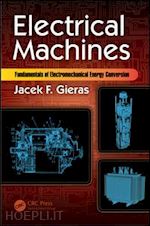Jacek F. Gieras graduated in 1971 from the Technical University of Lodz, Poland with distinction. He received his PhD degree in electrical engineering (electrical machines) in 1975 and DSc degree (Dr habil.), also in electrical engineering, in 1980 from the University of Technology, Poznan, Poland. His research area is electrical machines, drives, electromagnetics, power systems, railway engineering and aircraft electric systems. Major research achievements relate to analytical methods of analysis of power frequency electromagnetic fields, linear motors, magnetic levitation, computer aided design of electrical motors, new topologies of permanent magnet motors, and optimization of permanent magnet brushless motors using the finite element method and population-based algorithm. He is an internationally recognized scientist and one of the leaders in electrical machines and electromechanical drives. His works on linear motors and permanent magnet motors are frequently cited worldwide (over 4500 citations). From 1971 to 1987, he was with Poznan University of Technology, Poznan, and Academy of Technology and Agriculture, Bydgoszcz, Poland. In 1975/76 (6 months) he was a Visiting Researcher at Czechoslovak Academy of Sciences (Laboratory of Electromagnetics), Prague, Czechoslovakia. From 1983 to 1985, he was a Research Visiting Professor at Queen's University, Kingston, Ontario, Canada. In 1987, he was promoted in Poland to the rank of Full Professor of Electrical Engineering (life title given by the President of the Republic of Poland). From 1987 to 1989, he was with the Department of Electrical Engineering at Jordan University of Science and Technology, Irbid, the Hashemite Kingdom of Jordan. From 1989 to 1998, he was with the Department of Electrical Engineering at the University of Cape Town, South Africa. In 1994, he was a Visiting Professor at the University of Rome La Sapienza, Italy. In 1996, he was JR Central Company Visiting Professor (Endowed Chair of Transportation System Engineering established by Central Japan Railway Company) at the University of Tokyo, Japan. In 1996/1997, he was a Guest Professor at Chungbuk National University (School of Electrical and Electronics Engineering), Cheongju, South Korea. Prof. Gieras has authored and co-authored 11 books, over 250 scientific and technical papers, and over 70 patents and patent publications. His monograph, "Linear Induction Motors", Oxford University Press, 1994, U.K. is the fundamental reference book in linear induction machines. He co-authored an 800-page "Handbook of Electric Motors", Marcel Dekker Inc., New York, U.S.A. edited by W.H. Middendorf and R.H. Engelmann (University of Cincinnati). The second edition was published in 2004 (editors H. Toliyat and J. Kliman). His book entitled, "Permanent Magnet Motors Technology: Design and Applications", Marcel Dekker Inc., New York, 1996, second edition 2002, 3rd edition 2010 offers comprehensive coverage of all types of rotary permanent magnet motors, their modern applications, design, and principles of optimization. Permanent magnet linear synchronous motors have been discussed in his book entitled, "Linear Synchronous Motors: Transportation and Automation Systems", CRC Press LLC, Boca Raton, Florida, 1999 (co-author Z.J. Piech), 2nd edition 2012 (co-authors Z.J. Piech and B. Tomczuk). "Noise of Polyphase Electric Motors", Taylor & Francis, CRC Press, Boca Raton, FL, U.S.A., 2005 (coauthors C. Wang and J.C. Lai), is the first in the world monograph which discusses magnetic noise produced by permanent magnet brushless motors. "Advancements in Electric Machines", Springer, Dordrecht-New York-London, 2008, is the first book in the world on most recent advances in electrical machinery and drives. Prof. Gieras is a Fellow of IEEE (Institute of Electrical and Electronics Engineers, U.S.A.), Fellow of UTC Aerospace Systems (United Technologies Corporation), U.S.A., Full Member of International Academy of Electrical Sciences, foreign member of PTETiS (Polish Association of Theoretical and Applied Electrotechnology), and member of steering committees of numerous international conferences.












